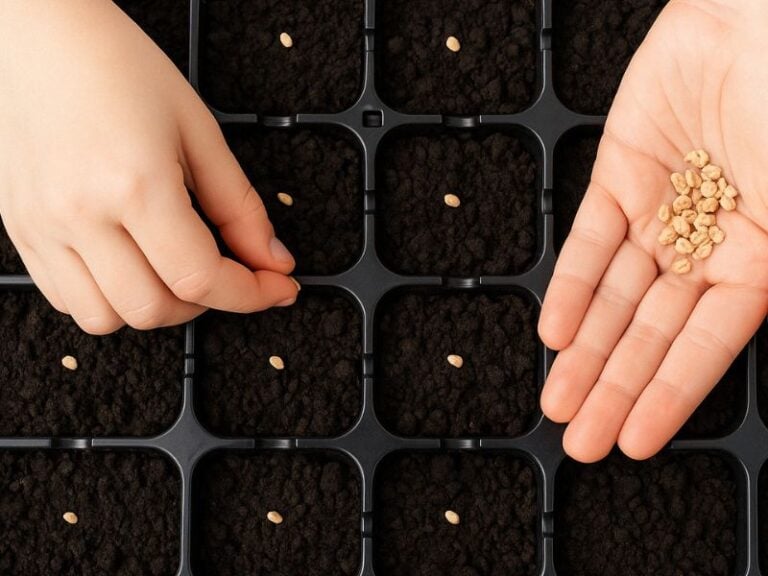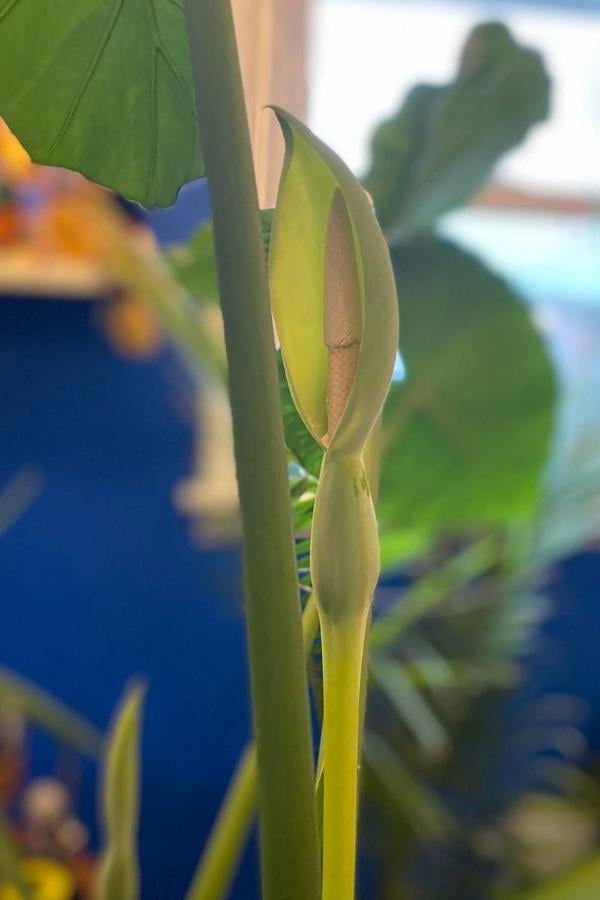If you let your precious plumeria grow outside without any restrictions, it will reach a height of up to 25 feet when fully grown.
The canopy will also have the same width spread. However, keeping plumerias compact makes them appear and feel more aesthetically pleasing.
It’s also simple to train your plumeria to be small.
Grow your plumeria in a pot to keep it small. Make sure to prune it regularly, limit the amount of water you give it, and cut it back. Choose compact varieties such as Dwarf Pink Singapore (Plumeria obtusa) and Dwarf Watermelon for the best results.

Contents
- How to Keep Plumeria Leaves from Growing
- Pruning Plumerias To Keep Them Small
- Hard Pruning Plumeria
- Grow a Dwarf Plumeria Variety
- Do Plumerias Like Small Pots?
- How Do You Shape A Plumeria Tree?
- When Should I Cut Back My Plumeria?
How to Keep Plumeria Leaves from Growing
Compact plumeria plants are ideal for small patios, balconies, urban gardens, and indoor spaces.
Unfortunately, frangipanis are flowering tropical trees genetically programmed to grow rapidly, reaching a towering height and a wide spread of 20 to 25 feet (6 to 7.6 meters).
Slowing down the growth of leaves is one of the most effective ways to keep your plumeria small. How so?
[1] Prune Your Plumeria Regularly
If you allow your plumeria tree’s leaves to grow freely, it will grow very tall. A garden-grown specimen grows 18-24 inches annually, making it a fast grower.
Therefore, pruning your tropical beauty regularly is necessary to keep your tree small, manageable, and ornamentally compact.
Trimming off the larger foliage will help you deal with fast-growing plumeria.
[2] Limit the Amount of Water You Give Your Plumeria
Plumerias prefer uniformly moist soil and will use any extra moisture available to support additional growth.
Every week, your tree will need about an inch of water.
However, depending on the size and prevalent conditions such as light, temperature, and air circulation, it can do with more or less water.
When you limit the amount of water you give your plumeria, the soil’s moisture decreases, which helps stunt or slow its growth.
Remember that water is essential for your tree’s biological processes, such as photosynthesis.
Trees use water and sunlight as energy sources to produce sugars, which power everything in this critical process.
Your plumeria’s growth is made of carbs that are made by photosynthesis.
These carbs are the building blocks for all parts of the plant’s growth.
Reduce the amount of water available to your plant, which will produce fewer carbs through photosynthesis, lowering the likelihood of new growth.
Fortunately, established frangipani trees are highly resilient and drought-resistant, so withholding water will generally have no effect on their overall health.
You will not kill your tree but rather slow its growth. When your plumeria goes dormant in the winter, you can reduce watering frequency even further.
However, you won’t have to worry about this in USDA hardiness zones 10 through 11.
Allow the top two to three inches of the soil of a potted plumeria to completely dry out before watering again.
[3] Growing Plumeria in Pots
Growing your plumeria in a pot is a fantastic idea for various reasons. It can be placed almost anywhere.
Its fragrance will fill even the smallest corner of your home or office, and its compact size allows you to grow many plants in a small space.
Plumeria grows well in pots as well. When the cold weather arrives, you can move your container tree to a sheltered location like a garage.
After all, frangipanis are extremely sensitive to frost and cold drafts and frequently require protection from late fall to early spring.
The frangipani thrives in small spaces, so potting your plumeria makes it an excellent choice for your patio. Container frangipanis are excellent for sunny balconies, decks, and courtyards.
However, for the purposes of this discussion, growing your plumeria in a pot is a simple and effective way to keep it small.
Most plumeria varieties can be potted because the container will keep the roots and tree from growing to maturity.
Here’s how to grow plumeria trees in pots:
Step #1 – Choose the Right Container
Plumeria trees, like most tropical plants, dislike standing on “wet feet,” and prolonged soggy soil conditions promote root rot. That is why a well-draining pot is essential.
However, the best pot for your plumeria should:
- Be made of a porous material, such as terracotta or unglazed clay. As a result, non-porous containers such as plastic and glazed ceramic pots should be avoided.
- Be sterile and clean – I recommend using a fresh pot. You can clean the pot with soapy water and then rinse it with a 10% bleach solution (mix 1 part bleach and nine parts water)
- Have adequate drainage holes in the bottom. These should allow excess water runoff from the bottom to escape and keep the soil from becoming slurry or soggy. I recommend two or three good-sized drainage holes.
- Be of the correct size – Choose a large, large plant container to hold your plumeria roots without being overcrowded.
Step #2 – Pick the Correct Potting Mix
First, choose a well-draining potting medium for your plumeria. It is the most effective method of preventing waterlogging and root rot.
Fortunately, plumeria can grow in various soil types as long as they drain well. It grows best in a rich, loamy, well-drained medium. Ascertain that the soil pH is neutral or slightly acidic.
A high-quality commercial potting mix is available for purchase. Or, like me, you can prepare your own mix to save money.
Combine crushed pumice (vermiculite will also work), shredded redwood or orchid bark, and regular potting soil in an equal parts ratio.
Step #3 – Prepare for Potting
Half-fill the pot with potting mix. Check that the soil is not oozing out of the drainage holes. To avoid this, I frequently use a small rock or meshing.
Step #4 – Planting your Plumeria
Plant your frangipani in the center of the pot, ensuring the roots are evenly distributed.
Fill the remaining space in the pot with potting mix and press down on the ends to keep your plumeria stable.
Step #5 – Positioning the Container
Place the potted plumeria in a location that receives six to eight hours of direct sunlight per day.
Place it away from the concrete because frangipanis don’t like the heat reflected by concrete.
The ideal location for your plumeria is where the canopy receives direct sunlight while the roots receive some shade.
Step #6 – Caring for your Potted Plumeria
- Watering – Overwatering is the most common problem with plumeria, so avoid it. Before watering, make sure the top of the soil is completely dry. Check the soil moisture daily during the hot summer months of growth.
- Light – Frangipanis prefer dappled light (partial shade and sun) but thrive in full sun. Make sure it gets at least 6 hours of sunlight per day.
- Humidity & temperature –Plumeria thrives in hot weather and high humidity.
- Fertilizer – Feed your plumeria half the strength of a high-phosphate fertilizer. Simultaneously, avoid high-nitrogen fertilizers, which will promote a rush of foliage.
Pruning Plumerias To Keep Them Small
Get Rid of the Older Leaves
In practice, I’ve discovered that starting with older, more frail leaves serves a dual purpose.
It will direct resources (nutrients, water, and energy) to where they are most needed.
At the same time, removing old foliage will ensure that your plumeria looks beautiful.
Begin pruning with leaves that have significant signs of fading, yellowing, damage, or spots.
Older plumeria leaves that have been ripped, split, or torn are for sale.
Use a pair of pruning shears that are clean, sharp, and sterile. A good pair of needle nose hand shears are my favorite prune tool.
Prune Your Plumeria in Spring
In general, the best time to prune your plumeria trees is at the start of the growing season.
Most plumeria varieties, such as Plumeria rubra and Plumeria obtusa, begin new growth in early spring.
Of course, you can remove any dead, diseased, or dying leaves, twigs, and branches at any time of year to keep your plumeria in good health.
Pruning your plumeria in the late winter is also acceptable, as growth is slowing.
When pruning your tree, keep in mind that the tips of the branches are responsible for the plumeria’s highly prized flowers.
As a result, any branch that you prune will not bloom until the following growing season, so be cautious when pruning.
Pruning Plumeria to Keep them in Shape
Plantation owners in the tree’s tropical native regions of the Lesser Antilles, Puerto Rico, and the Caribbean usually prune off all the lower branches to create a taller tree with a chunky main trunk.
That is not what you want if you want to grow a more compact and desirable houseplant.
Instead, trim all of the branches to about half their original length. That’s how you make a shrub that’s denser, shorter, and easier to manage.
Naturally, you’ll want to prune the tree’s top to help limit its height and encourage new lateral branches to grow on the sides.
This method aids in giving your plumeria tree a fuller, more appealing shape.
Pruning Potted Plumeria
You might believe that a potted plumeria tree grows slowly and does not require pruning. You would, however, be incorrect.
A potted plumeria could also benefit from regular pruning (at least once a year) to keep it compact.
When pruning, look for signs of common issues such as yellowing leaves and soft, spongy, or wrinkled branches.
The latter is typically caused by a fungus in the branches or roots, and it is frequently aided by overwatering or cool, wet conditions.
Remember to use pruning to check for pests such as nematodes, mealybugs, caterpillars, frangipani moths, and scale insects.
Hard Pruning Plumeria
Hard pruning a plumeria is a great way to eliminate old growth and maintain a compact shape.
It will also reduce the strain and stress from the old growth.
The best time to hard prune deciduous varieties of plumeria is when they enter dormancy during the winter or fall.
Use a heavy, long-handled garden pruner if the branches you want to hard prune are smaller than 1.75 inches (4.5 cm) in diameter.
You can use a pruning saw for branches thicker than that. Cut at an angle around a quarter inch above an out-facing node or bud.
Grow a Dwarf Plumeria Variety
The most effective way to keep your plumeria small is to grow a dwarf frangipani variety. After all, genetics almost always wins!
For instance, Dwarf Pink Singapore (aka petite pink) is a compact variety that reaches around three feet (about a meter) high at maturity.
Take your pick from the dwarf plumeria varieties I’ve listed in the table below:
| Dwarf Plumeria Varieties | Dwarf Plumeria Height |
| Dwarf Pink Singapore (Plumeria obtusa) | 3 ft. (1 m) |
| Dwarf Watermelon | 8-10 ft. (2.4-3 m) |
| Dwarf Deciduous Plumeria | 5 ft. (1.5 m) |
| Dwarf Orange Plumeria | 4 ft. (1.2 m) |
| Plumeria ‘Dwarf Richard Criley’ | 5 ft. (1.5 m) |
| Duang Suree aka Dwarf Nok Plumeria | 4 ft. (1.2m) |
Do Plumerias Like Small Pots?
Plumerias can thrive in small pots as long as their size is kept to a minimum.
A too-small container results in a top-heavy plant, which causes the pot to tip over. A heavy pot is an excellent solution.
How Do You Shape A Plumeria Tree?
Pruning is the best way to shape your plumeria tree. Prune the top branches to encourage a fuller, more robust shape.
Trim off any branch with 3-4 other sub-branches distended from it.
When Should I Cut Back My Plumeria?
Early spring before new growths appear is the best time to prune back your plumeria.






